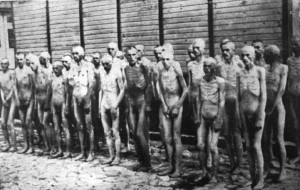In “States of Exception: the Nazi-Soviet War as a System of Violence, 1939-1945” Mark Edele and Michael Geyer analyze the mindset of war and the onset of extreme violence in Nazi Germany and Stalinist Russia. The authors posit that the devastation and violence that accompanied the war was a result of the mutual hostility between Nazi Germany and the Soviet Union. Additionally they argue that this war was fought “as a war on an interior and an exterior front” and that the escalation and radicalization of the war had a tremendous psychological impact on soldiers which further contributed to the prevalence of violence. ((Edele, Mark and Michael Geyer. “States of Exception.” In Beyond Totalitarianism: Stalinism and Nazism Compared, New York: Cambridge University Press, 2009: 348-350.)).
Several particularly interesting aspects discussed throughout this article were the ideas of an interior/exterior war and the thoughts and actions of soldiers in context to the “win and live or lose and die” mindset ((Edele and Geyer. “States of Exception.” 359.)). Both countries waged war internally against those they saw as inferior or detrimental to the cause. For the Soviet Union, it threatened extermination to individuals that did not adhere to their ideology. Similarly, Germany practiced such extermination policies on the Jewish population. Edele and Geyer cite that the Holocaust was the “pivotal aspect of this civil war of all-out extermination”. ((Edele and Geyer. “States of Exception.” 349)).
On the exterior front, soldiers engaged in incredibly violent acts. Beyond coercion and fear the Germany army created tactical policies based on the idea that people are more inclined to kill when “motivated by a concrete social unit” ((Edele and Geyer. “States of Exception.” 387-388)). The Soviet Union also used similar techniques to promote emotional ties among soldiers. Because of the high mortality rates, both armies used emotional bonds between soldiers to promote ideas of hatred, revenge and violence on the enemy who killed their comrade. These feelings dehumanized the enemy and many soldiers saw the enemy not as individuals but as “foul beasts, drunk with blood” ((Edele and Geyer. “States of Exception.” 390)). Both Nazi Germany and the Soviet Union used the powerful combination of a dehumanized enemy and strong emotional ties between soldiers to further perpetuate such atrocities.
In a previous class when we discussed the Great Purges in Sheila Fitzpatrick’s article “A Time of Troubles”. At the end of the class we came to the conclusion that this type of state violence was a result of the Soviet state being hyper-rational. Can the type of extreme violence seen during the Nazi-Soviet War be explained rationally or logically? Why or why not? On a second note, what would you argue to be the main catalyst(s) for the escalation of violence during this period?

